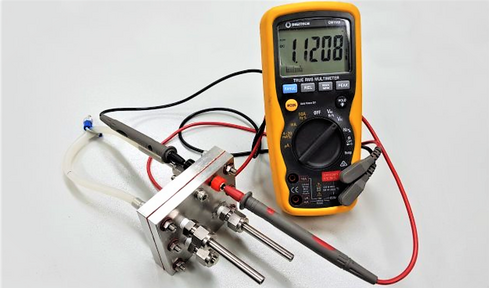Researchers at Royal Melbourne Institute of Technology (RMIT) have pioneered the world's first rechargeable proton battery and said it will be available in 5-10 years, challenging existing lithium battery technology.
The advantage of a proton battery combined with a hydrogen fuel cell is that it is a fairly environmentally friendly battery that can be fabricated without the need for metal. And the latest technology makes this process reversible and can be recharged. During the charging of the proton battery, the carbon in the electrode combines with the generated protons to break down the water with the help of a power source. The protons are again released and returned through the reversible fuel, forming water with oxygen in the air to generate electricity. Unlike fossil fuels, carbon does not burn or cause emissions during this process.
The key to the technology is that during the charging process, protons generated by the decomposition of water in the reversible fuel cell are conducted through the cell membrane, and the electrons supplied by the applied voltage are directly combined with the storage material without forming hydrogen. Its energy efficiency is comparable to that of lithium-ion batteries because it avoids the loss of hydrogen evolution and splitting into protons.
Lead researcher Professor John Andrews pointed out that the original hydrogen fuel cell is not only difficult to recharge, but still needs to use high-priced rare metals, but its proton battery technology has taken a key step toward environmentally friendly energy in the future. He stressed that proton batteries are mainly composed of carbon, which is a richer and cheaper raw material than hydrogen storage alloys and metals such as lithium, which can alleviate the demand for rare metals in today's energy storage technology.
Not only that, but its performance is also quite good. According to experimental results, the 5.5 cm2 active internal surface area can store energy equivalent to that of a commercially available lithium ion battery, and this is still an unoptimized prototype. John Andrews said that future work will focus on further improving battery performance and energy density through atomic-grade thin-layer carbon-based materials such as graphene, and challenging the market position of lithium-ion batteries, which are widely used in power grids and household energy storage.

The results of the study have been published in the International Hydrogen Energy Journal, and the prototype currently being developed by the laboratory is a small battery with only 1.2V. The latest version will provide an integrated rechargeable unit. Part of this research was funded by the Australian Defence Science and Technology Group and the US Naval Research Global Office.
All power to the proton: researchers make battery breakthrough
Move over, lithium! Researchers create world's first rechargeable proton battery
Copy paper
Copy paper is the most consumed material in xerographic copiers and the embodiment of copy quality. In daily work, copy paper is used most frequently.
The quality of copy paper will directly affect the speed of work efficiency and the appearance of text.
The main brands are APP, Tianzhang, Yatai, etc.
The paper can be white or color. Most laser printers are designed to use paper weighing about 70-90 grams per square meter,
and the raw material is 100% pure wood pulp.
When we buy copy paper, we mainly refer to the following aspects: thickness, density, stiffness, and luminosity. If this is four degrees, we will buy copy paper that suits us. Everyone uses different places, so they have different requirements for paper.
Some need to use good paper, and some need to be simple and usable. Thickness refers to how many grams we usually say, density refers to the density and thickness of the paper, the denser the thinner the better, the stiffness refers to the hardness of the paper, the stiffness is high, the paper is hard, and the brightness refers to The surface finish of the paper.
Copy Paper,Carbon Copy Paper,Laser Copy Paper,Colored Copy Paper
Shijiazhuang Qiancen Industry Co.,ltd , https://www.yuyilang.com